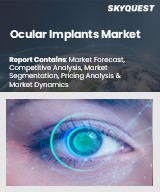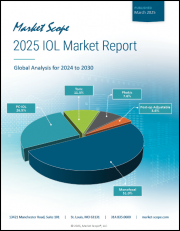
|
시장보고서
상품코드
1504234
안내 렌즈 시장 규모, 점유율, 예측, 동향 분석, 유형별, 재료별, 용도별, 최종 사용자별 - 세계 시장 예측(-2031년)Intraocular Lens Market Size, Share, Forecast, & Trends Analysis by Type (Monofocal, Multifocal, Toric, Phakic) Material (Hydrophobic Acrylic, PMMA, Silicone) Application (Cataract, Astigmatism, Corneal Disorders) End User - Global Forecast to 2031 |
||||||
안내 렌즈 시장은 2024-2031년간 6.5%의 연평균 복합 성장률(CAGR)로 성장하여 2031년에는 71억 7,000만 달러에 달할 것으로 예상됩니다.
이 보고서는 종합적인 1차 및 2차 조사, 시장 시나리오에 대한 심층 분석을 바탕으로 업계의 주요 동인, 제약, 도전 과제, 기회를 제공합니다. 노인 인구 증가, 백내장 수술 건수 증가, 디지털 기기 과다 사용으로 인한 시각 장애, 안과 의료 서비스 접근성 향상을 위한 정부의 이니셔티브와 재정 지원 등이 이 시장을 주도하고 있습니다.
또한, 최소 침습적 안과 수술에 대한 선호도가 높아짐에 따라 이 시장에 큰 성장 기회를 제공합니다. 그러나 안내 렌즈의 높은 비용과 상환 정책의 부재는 성장을 저해할 수 있습니다. 또한, 안내 렌즈의 드문 합병증은 이 시장에서 활동하는 기업들에게 도전이 되고 있습니다.
목차
제1장 서론
제2장 조사 방법
제3장 주요 요약
제4장 시장 인사이트
- 개요
- 성장 촉진요인
- 성장 억제요인
- 기회
- 과제
- 기술 동향/시장 동향
- 규제 시나리오
- 가격 분석
- Porter의 Five Forces 분석
제5장 세계의 안내 렌즈 시장 : 유형별
- 개요
- 단초점 렌즈
- 다초점 렌즈
- 굴절 교정 렌즈
- 토릭 렌즈
- Phakic Lenses
- 기타 유형
제6장 세계의 안내 렌즈 시장 : 재료별
- 개요
- 소수성 아크릴
- 친수성 아크릴
- 폴리 메타크릴산메틸(PMMA)
- 실리콘
- 기타 재료
제7장 세계의 안내 렌즈 시장 : 용도별
- 개요
- 백내장 수술
- 난시 수술
- 각막 질환
- 기타 용도
제8장 세계의 안내 렌즈 시장 : 최종사용자별
- 개요
- 병원
- 안과 클리닉
- 외래수술센터(ASC)
제9장 안내 렌즈 지역별 시장
- 개요
- 북미
- 미국
- 캐나다
- 유럽
- 독일
- 프랑스
- 영국
- 이탈리아
- 스페인
- 스위스
- 아일랜드
- 덴마크
- 벨기에
- 기타 유럽
- 아시아태평양
- 중국
- 일본
- 인도
- 한국
- 기타 아시아태평양
- 라틴아메리카
- 브라질
- 멕시코
- 기타 라틴아메리카
- 중동 및 아프리카
제10장 경쟁 분석
- 개요
- 주요 성장 전략
- 경쟁 벤치마킹
- 경쟁 대시보드
- 시장 리더
- 차별화 요인
- 선행 기업
- 신규 기업
- 시장 점유율 분석(2023년)
제11장 기업 개요(기업 개요, 재무 개요, 제품 포트폴리오, 전략적 전개)
- Alcon, Inc.
- Johnson & Johnson Services, Inc.
- Carl Zeiss Meditec AG
- Hoya Corporation
- Beaver-Visitec International
- Ophtec B.V.
- Appasamy Associates Private Limited
- Atia Vision, Inc.
- LENSTEC, Inc.
- Santen Pharmaceutical Co., Ltd.
- Rayner Group
- EyeKon Medical, Inc.
- Humanoptics Holding AG
(주 : 주요 5개사의 SWOT 분석을 게재)
제12장 부록
LSH 24.07.10Intraocular Lens Market Size, Share, Forecast, & Trends Analysis by Type (Monofocal, Multifocal, Toric, Phakic) Material (Hydrophobic Acrylic, PMMA, Silicone) Application (Cataract, Astigmatism, Corneal Disorders) End User-Global Forecast to 2031
The intraocular lens market is projected to reach $7.17 billion by 2031, at a CAGR of 6.5% from 2024 to 2031.
Following a comprehensive primary and secondary study and an in-depth analysis of the market scenario, this report provides the key drivers, constraints, challenges, and opportunities of the industry. This market is driven by the rising geriatric population, increasing number of cataract surgeries, visual impairment due to excessive use of digital devices, and government initiatives and funding to improve accessibility to eye care services.
Furthermore, the rising preference for minimally invasive ophthalmic surgeries provides a significant growth opportunity for this market. However, the high costs of intraocular lenses and the unavailability of reimbursement policies may restrain its growth. Additionally, rare complications of IOL pose a challenge for the players operating in this market.
Among types, in 2024, the multifocal intraocular lenses segment is expected to account for the largest share of 28.9% of the intraocular lens market. The large share of the segment is attributed to factors such as proven/predictable results, cost-effectiveness, minimum maintenance, and the high prevalence of cataracts in older people. The key market players are undertaking various strategic initiatives to innovate multifocal intraocular lenses. For instance, in July 2022, Lenstec, Inc. (U.S.) received U.S. Food and Drug Administration (FDA) approval for the SBL-3 Multifocal Intraocular Lens (IOL), which is permanently implanted inside the eye. The SBL-3 is a multifocal intraocular lens with two zones that focus light-one from objects far away (distance vision) and the other from objects close up (near vision).
Among materials, in 2024, the hydrophobic acrylic segment is expected to account for the largest share of the intraocular lens market. Hydrophobic acrylic is the most commonly used type of material in IOLs. This material is composed of crosslinked copolymers of acrylic esters and other acrylic ester co-monomers, with a carbon backbone and ester side groups. The large share of the segment is attributed to factors such as the increasing popularity of ophthalmologists, good mechanical stability, good uveal biocompatibility, ease of manufacturing, and lower rates of complications in IOL.
Among applications, in 2024, the cataract surgery segment is expected to account for the largest share of the intraocular lens market. The large share of the segment is attributed to factors such as the increasing number of cataract surgeries, growing demand for intraocular lenses, and increasing technological advancements in intraocular lenses.
Among end users, in 2024, the hospitals products segment is expected to account for the largest share of the intraocular lens market. The large share of the market is attributed to factors such as the increasing prevalence of eye diseases and disorders and increasing awareness of ocular diseases leading to rising visits to hospitals.
An in-depth analysis of the geographical scenario of the intraocular lens market provides detailed qualitative and quantitative insights for the five major geographies (North America, Europe, Asia-Pacific, the Middle East & Africa, and Latin America) along with the coverage of major countries in each region. In 2024, Asia-Pacific is slated to register the highest CAGR of 8.5% of the intraocular lens market. The high growth of the segment is primarily attributed to the rising geriatric population in countries such as China and India, the adoption of advanced healthcare resources, and rising awareness regarding the benefits of vision care products. Furthermore, the increasing affordability and availability of vision treatment providers also contribute to the growth of this market.
The key players operating in the intraocular lens market are Alcon, Inc. (U.S.), Johnson & Johnson Services, Inc. (U.S.), Carl Zeiss Meditec AG (Germany), Hoya Corporation (Japan), Beaver-Visitec International (U.S.), Ophtec B.V. (Netherlands), Appasamy Associates Private Limited (India), Atia Vision, Inc. (U.S.), LENSTEC, Inc. (U.S.), Santen Pharmaceutical Co., Ltd. (Japan), Rayner Group (U.K.), EyeKon Medical, Inc. (U.S.), and Humanoptics Holding AG (Germany).
Scope of the Report:
Intraocular Lens Market-by Type
- Multifocal Lenses
- Monofocal Lenses
- Accommodative Lenses
- Toric Lenses
- Phakic Lenses
- Other Lenses
(Other lenses include extended depth-of-focus (EDOF) lenses and light adjustable lenses, among others)
Intraocular Lens Market-by Material
- Hydrophobic Acrylic
- Hydrophilic Acrylic
- Polymethyl Methacrylate
- Silicone
- Other Materials
(Other materials include Collamer (Collagen+Polymer) and PEG-PHS/HEMA/Styrene (PHS) Copolymer, among others)
Intraocular Lens Market-by Application
- Cataract Surgery
- Astigmatism
- Corneal Disorders
- Other Applications
(Other applications include presbyopia, nearsightedness, and farsightedness)
Intraocular Lens Market-by End User
- Hospitals
- Ophthalmic Clinics
- Ambulatory Surgery Centers
- Eye Research Institutes
Intraocular Lens Market-by Geography
- North America
- U.S.
- Canada
- Europe
- Germany
- France
- U.K.
- Italy
- Spain
- Switzerland
- Ireland
- Denmark
- Belgium
- Rest of Europe
- Asia-Pacific
- China
- Japan
- India
- South Korea
- Rest of Asia-Pacific
- Latin America
- Brazil
- Mexico
- Rest of Latin America
- Middle East & Africa
TABLE OF CONTENTS
1. Introduction
- 1.1. Market Definition & Scope
- 1.2. Market Ecosystem
- 1.3. Currency & Limitations
- 1.4. Key Stakeholders
2. Research Methodology
- 2.1. Research Approach
- 2.2. Process of Data Collection and Validation
- 2.2.1. Secondary Research
- 2.2.2. Primary Research/Interviews with Key Opinion Leaders of the Industry
- 2.3. Market Sizing and Forecast
- 2.3.1. Market Size Estimation Approach
- 2.3.2. Growth Forecast Approach
- 2.3.3. Market Share Analysis
- 2.4. Assumption for the Study
3. Executive Summary
4. Market Insights
- 4.1. Overview
- 4.2. Drivers
- 4.2.1. Rising Geriatric Population
- 4.2.2. Increasing Number of Cataract Surgeries
- 4.2.3. Visual Impairment Due to Excessive Use of Digital Devices
- 4.2.4. Government Initiatives and Funding to Improve Accessibility to Eye Care Services
- 4.3. Restraints
- 4.3.1. High Costs of Intraocular Lenses
- 4.3.2. Unavailability of Reimbursement Policies
- 4.4. Opportunities
- 4.4.1. Rising Preference for Minimally Invasive Ophthalmic Surgeries
- 4.5. Challenges
- 4.5.1. Rare Complications of Intraocular Lenses
- 4.6. Technology Trends/Market Trends
- 4.6.1. Emergence of New Technologies in Intraocular Lenses
- 4.6.2. Use of Next-Generation Monofocal IOLs
- 4.6.3. Growing Use of Biocompatible Materials in Lenses
- 4.7. Regulatory Scenario
- 4.8. Pricing Analysis
- 4.9. Porter's Five Forces Analysis
5. Global Intraocular Lens Market-by Type
- 5.1. Overview
- 5.2. Monofocal Lenses
- 5.3. Multifocal Lenses
- 5.4. Accommodative Lenses
- 5.5. Toric Lenses
- 5.6. Phakic Lenses
- 5.7. Other Types
6. Global Intraocular Lens Market-by Material
- 6.1. Overview
- 6.2. Hydrophobic Acrylic
- 6.3. Hydrophilic Acrylic
- 6.4. Polymethyl Methacrylate (PMMA)
- 6.5. Silicone
- 6.6. Other Materials
7. Global Intraocular Lens Market-by Application
- 7.1. Overview
- 7.2. Cataract Surgery
- 7.3. Astigmatism
- 7.4. Corneal Disorders
- 7.5. Other Applications
8. Global Intraocular Lens Market-by End User
- 8.1. Overview
- 8.2. Hospitals
- 8.3. Ophthalmic Clinics
- 8.4. Ambulatory Surgery Centers
9. Intraocular Lens Market-by Geography
- 9.1. Overview
- 9.2. North America
- 9.2.1. U.S.
- 9.2.2. Canada
- 9.3. Europe
- 9.3.1. Germany
- 9.3.2. France
- 9.3.3. U.K.
- 9.3.4. Italy
- 9.3.5. Spain
- 9.3.6. Switzerland
- 9.3.7. Ireland
- 9.3.8. Denmark
- 9.3.9. Belgium
- 9.3.10. Rest of Europe
- 9.4. Asia-Pacific
- 9.4.1. China
- 9.4.2. Japan
- 9.4.3. India
- 9.4.4. South Korea
- 9.4.5. Rest of Asia Pacific
- 9.5. Latin America
- 9.5.1. Brazil
- 9.5.2. Mexico
- 9.5.3. Rest of Latin America
- 9.6. Middle East & Africa
10. Competition Analysis
- 10.1. Overview
- 10.2. Key Growth Strategies
- 10.3. Competitive Benchmarking
- 10.4. Competitive Dashboard
- 10.4.1. Market Leaders
- 10.4.2. Market Differentiators
- 10.4.3. Vanguards
- 10.4.4. Emerging Companies
- 10.5. Market Share Analysis (2023)
11. Company Profiles (Company Overview, Financial Overview, Product Portfolio, and Strategic Developments)
- 11.1. Alcon, Inc.
- 11.2. Johnson & Johnson Services, Inc.
- 11.3. Carl Zeiss Meditec AG
- 11.4. Hoya Corporation
- 11.5. Beaver-Visitec International
- 11.6. Ophtec B.V.
- 11.7. Appasamy Associates Private Limited
- 11.8. Atia Vision, Inc.
- 11.9. LENSTEC, Inc.
- 11.10. Santen Pharmaceutical Co., Ltd.
- 11.11. Rayner Group
- 11.12. EyeKon Medical, Inc.
- 11.13. Humanoptics Holding AG
(Note: SWOT analysis of the top 5 companies is provided.)
12. Appendix
- 12.1. Available Customization
- 12.2. Related Reports



















